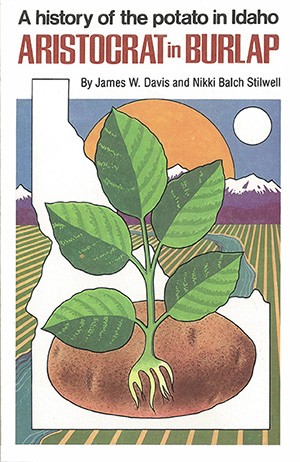 (TOP)Defects were trimmed from potatoes before dicing and drying.
(BOTTOM)Jack Simplot poses in potato storage at Caldwell plant.
(TOP)Defects were trimmed from potatoes before dicing and drying.
(BOTTOM)Jack Simplot poses in potato storage at Caldwell plant.
Simplot aggressively sought new customers and bought out competitors as the tides of change convinced some shippers to leave the business. Jack Simplot concentrated his energy and ability to innovate in the fresh-produce business and by 1940 was the largest single shipper of Idaho® potatoes. He had 32 packing warehouses from American Falls to Jamison, Oregon, and in 1940 shipped 10,000 cars of Idaho® potatoes to receivers all over the United States. While his shipping empire was making great strides, Jack Simplot was also active in potato growing. Like other more progressive growers of his time, he tried certified seed and was enthusiastic with the results. Prior to this time, he had experienced crop failures when it was impossible to determine what had happened. Most growers were saving small potatoes from the previous year's crop to use as seed for the next season. Bacterial and viral diseases tended to grow worse under this practice and bad hereditary traits were kept in the growing operation rather than being replaced by better strains of seed.
Simplot started a system with growers from whom he bought potatoes. He would buy certified seed and induce each one of his growers to purchase ten or more bags from him on credit. They were instructed to plant these ten bags of potatoes late in the season, which caused the tubers to be small in size and relatively immature at harvest time. This lot of potatoes then, which had been grown from the certified seed and multiplied by one year's growing, served as the seed for the next year's crop. The practice, which Simplot developed, proved to be so superior to using "year out" seed that it became almost a universal practice in the potato-growing areas of Idaho.
In that period of Idaho agriculture, the use of chemical fertilizers was virtually unknown. Growers provided the nitrogen that was needed for a good potato crop by growing alfalfa hay on the land for two or three years and plowing under the last alfalfa crop. The nitrogen fixing ability of the alfalfa enriched the soil and made possible a potato crop that would yield high enough to be profitable. Some growers, however, tried growing potatoes after potatoes or on a short rotation cycle and found yields and quality falling off to a point where it was not profitable.
Jack Simplot recalls his introduction to chemical fertilizer by remembering one year when he purchased a carload of fertilizer from the Pacific Guano Fertilizer Company of California. The purchase was made from a salesman who was traveling in Idaho, and Simplot decided to try one carload as an experiment.


 (TOP)Defects were trimmed from potatoes before dicing and drying.
(BOTTOM)Jack Simplot poses in potato storage at Caldwell plant.
(TOP)Defects were trimmed from potatoes before dicing and drying.
(BOTTOM)Jack Simplot poses in potato storage at Caldwell plant.